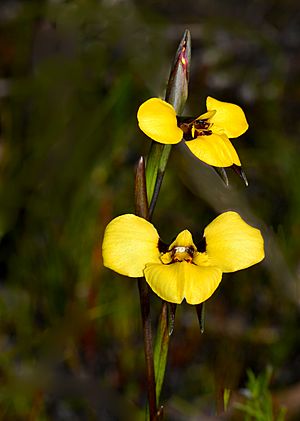Purdie's donkey orchid facts for kids
Quick facts for kids Purdie's donkey orchid |
|
|---|---|
 |
|
| Diuris purdiei near Armadale | |
| Conservation status | |
| Scientific classification | |
| Genus: |
Diuris
|
| Species: |
purdiei
|
Diuris purdiei, also known as Purdie's donkey orchid, is a special type of orchid. It grows only in the south-west part of Western Australia. This means it is endemic to that area. This orchid has five to ten leaves at its base. It can grow up to eight pale yellow flowers. These flowers often have reddish-brown or purplish marks. Purdie's donkey orchid usually lives in swampy places. It only blooms after fires have happened the summer before.
Contents
What Does Purdie's Donkey Orchid Look Like?
Purdie's donkey orchid is a tuberous, perennial herb. This means it has a round, underground storage part called a tuber. It also lives for more than two years. The plant has five to ten leaves that twist like a spiral. These leaves grow in a small bunch near the bottom of the plant.
Each leaf is about 50–100 mm (2–4 in) long. They are also about 2–3 mm (0.08–0.1 in) wide. The plant can have up to eight pale yellow flowers. These flowers have reddish-brown or purplish marks in the middle. Each flower is about 20–30 mm (0.8–1 in) long and 20–35 mm (0.8–1 in) wide. They grow on a stem that is 150–350 mm (6–10 in) tall.
Flower Parts and Features
The top part of the flower, called the dorsal sepal, stands up straight. It can also curve backward. It is about 10–12 mm (0.4–0.5 in) long and 4–5 mm (0.16–0.20 in) wide. The two side parts, called lateral sepals, are about 14–17 mm (0.6–0.7 in) long. They are about 2 mm (0.08 in) wide and point downwards.
The petals of the flower spread out wide. They are almost flat, like they are held horizontally. Each petal has an egg-shaped blade. This blade is about 8–10 mm (0.3–0.4 in) long and 7–9 mm (0.3–0.4 in) wide. It sits on a reddish-brown stalk that is 4–5 mm (0.16–0.20 in) long.
The labellum is a special lip-like part of the orchid. It is about 15–18 mm (0.6–0.7 in) long and has three parts, called lobes. The middle lobe is shaped like a heart and is 10–12 mm (0.4–0.5 in) wide. The two side lobes are 4–5 mm (0.16–0.20 in) long and about 2 mm (0.08 in) wide. They have edges that look like tiny saw teeth. There are also two small ridges, called calli, in the center of the labellum. They are about 6–7 mm (0.2–0.3 in) long. This orchid usually flowers in September and October.
How Purdie's Donkey Orchid Got Its Name
The Purdie's donkey orchid, Diuris purdiei, was first officially described in 1903. A scientist named Ludwig Diels wrote about it. He found a sample of the plant near Cannington. His description was published in a science journal.
The second part of its name, purdiei, is a way to honor someone. It was named after Alex Purdie. He was a chemist from New Zealand who collected the first sample of this orchid. This first sample is called the type specimen.
Where Purdie's Donkey Orchid Lives
Purdie's donkey orchid grows in swamps that are wet during winter. It likes to grow under thick bushes. You can find this orchid between the cities of Perth and Yarloop. These areas are part of the Jarrah Forest and Swan Coastal Plain regions in Western Australia.
Protecting Purdie's Donkey Orchid
The Purdie's donkey orchid is in danger. The Australian Government has listed it as "endangered" under a law called the Environment Protection and Biodiversity Conservation Act 1999. The Department of Environment and Conservation in Western Australia also calls it "Threatened Flora."
This orchid's population has become split up. This happened because cities have grown and taken over its natural home. The biggest threats to this special orchid are losing its habitat and being taken over by weeds. Weeds are plants that grow where they are not wanted. They can harm the orchid by taking its water and nutrients.


